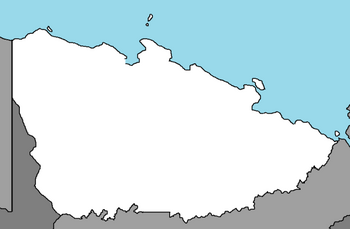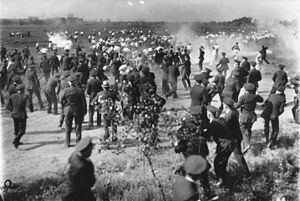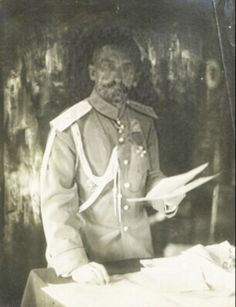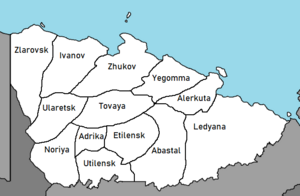Slavic Union
Slavic Union Славянский союз Slavyanskiy Soyuz | |
|---|---|
| Motto: "Potrebnosti naroda prevyshe vsego!" (Russian) "The Needs of the People Above All!" | |
| Anthem: "O dorogaya Slaviya (Russian)" Oh dear Slavia | |
 | |
| Capital | Adrikagorod |
| Official languages | |
| Ethnic groups |
|
| Demonym(s) | Slavic |
| Government | Federal Semi-Presidential Republic |
| Ulyana Agapova | |
| Mikhail Franko | |
• Deputy President | Vacant |
| Legislature | National Assembly |
| Senate | |
| Chamber of Deputies | |
| Establishment | |
| April 12 518 | |
• Cardoza Manifesto Published | February 15 1915 |
• Nikifor Osipov made Vozhd | October 23 1940 |
• Ratification of the Slavic Constitution | September 4 2021 |
| Area | |
• | 2,583,404 sq mi (6,690,990 km2) |
| Population | |
• 2020 estimate | 78,277,904 |
• Density | 30.3/sq mi (11.7/km2) |
| GDP (PPP) | 2021 estimate |
• Total | 1.8 trillion |
• Per capita | 23,651 |
| Gini (2018) | 48 high |
| HDI (2019) | .781 high |
| Currency | Ruble |
| Driving side | Right |
| Calling code | +327 |
The Slavic Union (Slavic: Славянский союз, Slavyanskiy Soyuz) also commonly known as simply The Union is a nation located on the continent of Euronia in the Coalition of Crown Albatross, bordered by Gladysynthia, and Paraboca.
The nation's capital is located in Adrikagorod, with other major cities in Ivanovgorod, Khizny and Zhukovgrad. The nations west is heavily populated, with the majority of the east's population in the Ledanaya region living in small towns.
For centuries the Slavic Union was a series of small, constantly warring princedoms, until they were united into the Slavic Union in 518 in order to defend against the Gladysynthian kingdoms west of the Slavic lands. The Slavic Revolution would lead to the creation of a democratic system that would be overthrown in 1940 by Nikifor Osipov. In 2021 the August Revolution (Slavic Union) would overthrow the Slavic government and establish a republic.
History
Early History
The first settler of the modern day Slavic Union came during Second Great Iearth Migration dated to approximately 50,000-40,000 years BP. The first settlers came from Zamastan and were primarily hunter gatherers. The mountains near the middle of the country meant that settlement of the east was sparse.
For centuries the lands the now make up the Slavic Union were ruled by warring princedoms until the 500s where the Gladysynthian kingdoms attempted to conquer the princedoms, leading them to sign The Document of Unity, which united the princedoms into a confederation under Imperator Borislav I. The confederation allowed the princedoms to beat back the Gladysynthian kingdoms, and a national identity would begin to form.
Slavic Union
In 587 after decades of constant warfare the Gladysynthian kingdoms would lead one final decisive offensive deep into the Slavic countryside, cities were burnt and pillaged, but in 597, as they attempted to cross the mountains of Ledyanaya to reach Roksa and secure victory, winter set in. Thousands were trapped in the mountains, and it is said in Slavic legend that only 100 survived, with Gladsynthia temporarily crippled construction of The Imperators Line began, a massive wall of forts stretching across the Slavic-Gladsynthian border which stand to this day, considered on of the greatest wonders of the world.
In 673 Imperator Adrika I founded the city of Adrikagorod, making it the capital of the Slavic Union. In the late 700s Imperator Berislav II went on a massive campaign of conquest, conquering much of the areas that make up the nations northwest today. Christianity would come to the Slavic Union in the 10th century, with Slavic Paganism dying out by the 13th century, though it has seen a recent surge in popularity.
The Imperator Line would be expanded over the centuries, allowing the Union to remain in relative isolation, this isolation lead them to fall behind, and by the 1700s the Imperator Line could do nothing against the weapons of the this new world. In 1742 the Gladsynthian Empire demanded that the Slavic Union cede massive amounts of land, which added up to 10% of it's total landmass and 20% of it's population. The Union refused with Imperator Ivan VIII said to have spit on the paper the demands were written on.
The Gladsynthian empire promptly marched into the Slavic border town of Odizov, General Sandvik Fowler was apparently so confident that the Union would surrender in the face of the Gladsynthian army that he rode his horse into the town square to give a speech welcoming the townspeople into the empire. He would be shot just 5 words into said speech, and the army would be ran out of town by an angry mob. By the time Gladsynthia returned they would be met with the Slavic army, deciding it wasn't worth it Gladsynthia retracted their demands. This brought a massive wave of nationalist sentiment, with the princedoms that ruled over the regions of the Union slowly losing power.
The countries isolation lead to it being one of the last countries to abolish serfdom in 1878, after serfs across the nation revolted. In the late 19th century as technology advanced it was discovered that the originally near inhospitable Ledanaya region held bountiful natural resources, this brought the attention of the Parabocan Empire, which had started struggling since it's loss in the Parabocan war. The leaders of Paraboca believed that a successful attack against the Slavic Union would save the empire from destruction.
The Slavic famine of 1889 caused 100,000 deaths and reignited public angers against the monarchy.
Ledyanaya War
On June 21 1901 the Parabocan army invaded the Slavic Union, with the south quickly being overrun and the city of Khizny would be taken. But as Paraboca marched north the famously frigid Slavic winter set in. With Parabocan and Slavic forces digging trench systems along the front lines.
Little progress was made by either side, though the Imperator Line was modernized to defend against Paraboca. In June 1902 the weather was good enough to advance but the trenches made it practically impossible to advance. Trench warfare was a brutal game of attack after attack just to gain a little bit of land.
In early 1903, the heavily outmatched Slavic military finally broke, with it's line shattering and the Parabocan army making a rapid advance towards the city of Adrikagorod, the Battle of Adrikagorod would last 3 months with heavy casualties on both sides, eventually the Parabocan army would be forced to retreat.
The Slavic army managed to strengthen defenses while Paraboca recovered, and eventually it was virtually impossible for Paraboca to push any further north into the Union. In 1907, with Paraboca needing a victory quickly if they wanted to keep things on the homefront from collapsing into chaos they launched the Phoenix Offensive, where an army of 100,000 would go around Slavic defenses through through Ledanaya.
Parabocan high command heavily overestimated their ability to navigate the mountainous and icy terrain of Lenadaya, they also didn't account for the Okhotnik, special forces units made of natives of the Ledanaya region, specially trained in guerilla tactics. Tales of the Okhotnik quickly spread through the ranks of the Parabocan, causing hits to morale, there were exaggerated stories of them eating human flesh and removing organs. This caused thousands to desert, terrified of the okhotnik.
Parabocan forces were severely weakened, and by the time they reached Noyalensk they had no choice but to surrender. The war would officially end on on September 22 1908 with the signing of the Treaty of Khizny, forcing Paraboca to pay massive reparations and eventually causing their collapse in 1910.
This was ultimately a pyrrhic victory for the Slavic Union, with effects from the war causing the economy to crash in 1909, and massive turmoil arrising from this. In 1912 Imperator Aleksei II was assassinated, leaving his two year old son Peter II as the nations monarch.
Slavic Revolution
Main Page: Slavic Revolution
On August 8, 1914 Slavic soldiers open fire on peaceful protestors in Noyalensk, this would lead to months of turmoil which culminated in the February 15, 1915 publishing of the Cardoza Manifesto by Avdei Sergeyev, who had lived in Paraboca in exile since 1897, the Cardoza Manifesto called for a revolt against the monarchy. This call was heeded a month later on March 29th when soldiers in Noyalensk rose up in mutiny, by April 12th rebels in the city declared the First Slavic Republic, with the mutinying soldiers forming the Republican Army of the Union. On the 17th Sergeyev arrived in Noyalensk and was elected President of the Republic by the provisional government.
Over the coming months revolts popped up across the nation, with many declaring their allegiance to the republic, one of these revolts was in the town of Goleuz in the south, lead by Dementi Aksyonov. On June 17th Rettoa, a small part of the country in the southeast, broke off and declared independence from the Slavic Empire.
In July 1915 Avdei Sergeyev formed an alliance with Nikifor Osipov a general for the Slavic Empire, who had fallen out of favor with Prime Minister Nail Voronkov. On July 28th Osipov lead an army to surround the Imperial Palace, a half hour later Regent Grand Duke Boris delivered a decree of abdication on the 5 year old Peter II's behalf. After this the Slavic Republic officially took complete control of the country.
Soon after President Sergeyev appointed several people who had been involved in the monarchy, which angered many anti-monarchists in the country. By May of 1916 Sergeyev was yet to fulfill many of his promises, particularly with land reform, in response, on July 3rd Dementi Aksyonov presents his 13 Points to the Slavic Republic, a list of demands, when they refuse he takes up arms and declares the Slavic Peasants Republic based in the south.
The Peasant Republic laid claim to vast swaths of land, including not just the land of the Slavic Republic but beyond, the land they controlled in actuality was much smaller, at it's max extent it only held a couple of towns in the south, with the land they control varying based on wherever the Liberation Army was stationed at the time, Dementi Aksyonov spent the next two years fighting a brutal guerilla war against the Republic.
On May 14, 1918 Paraboca officially recognized Avdei Sergeyev as the Slavic President, and in response Askyonov lead an attack on the city of Buene Dara a month later, but this only lead to Paraboca sending an expeditionary force into the country to capture Aksyonov at the behest of the Slavic Republic. Aksyonov knew the terrain well and was able to escape the Parabocan force over and over again, his fame only growing among the Slavic people, ultimately in June 1919 Paraboca was left with no choice to return home with morale low and Sergeyev pressuring them to leave the country.
On January 22nd 1920 Aksyonov was forced to rest in the small town of Chilovsk after suffering a gunshot wound to the leg during battle, it is there that the Republican Army, lead by Nikifor Osipov, encircled Aksyonov and destroyed the Liberation Army, putting an end to the revolt. The revolution being commonly accepted to be officially over when the 1920 Constitution was ratified in June.
Slavic Republic
On July 30, 1931 Avdei Sergeyev died of a stroke after serving as President for the last 14 years. On February 5, 1935 his successor Victor Lavrentiev was assassinated, and from there things only got more unstable, as the economy struggled and unemployment skyrocketed.
In 1938 the unrest culminated in the Slavic General Strike, originally a strike of railroad workers it sparked into something much greater after the Adrikagorod Massacre, when Adrikagorod police opened fire on striking workers, killing 32 and injuring 17. Unions across all trades went on strike in solidarity with the railroad workers, further crippling an already weak economy.
On August 15, 1938 President Basil Avdeyev was found dead in his home, and his successor Dominique Ozerov was rumored to be a closeted communist. On October 13th Nikifor Osipov lead a coup against the Slavic government, seizing several government buildings and ordering the assassinations of various high ranking government officials, by 3 AM the next morning Osipov had complete control of the government.
Slavic Union
After taking power he declared martial law and took full control of the government in order to put down riots across the country and to restore order. By 1942 stability had returned to the Slavic state for the first time in years, but Osipov was not done, he began instituting his New Unity policies, the institution of which would be the basis for all Osipovist politicians for the future. Osipov increased corporate cooperation with the state and introduced several public works projects, the most notable of which being the Vozhd line, a defensive line on the Slavic border, essentially turning the nation into a giant impenetrable fortress, Osipov also massively ramped up military production in the pursuit of armed neutrality. Osipov further consolidated his power in the state, making the PSS the only legal party within the nation. While anyone outside the Union would've seen Osipov as a dangerous tyrant he had near universal support among the people of the Union, who viewed him as the hero who won the Slavic Revolution and once again saved the nation from chaos in 1940.
World War
The Union maintained an armed neutrality, as it would through most conflicts, during the World War it's borders were heavily fortified and constantly patrolled in preparation for an attack by either side. This military build up lead to a revitalized arms industry, further establishing the Military-Industrial Complex within the Union.
Upon the outbreak of the war there was massive support among the population for intervention in the conflict, despite this Osipov was hesitant due to the Union having still not fully recovered from the civil war despite the conflict having ended 20 years earlier.
In Fall of 1949, with Nikifor Osipov receiving massive pressure to join the war he manages to compromise with interventionists in the nation by signing the Slavic-Drambenburg Aid Treaty, temporarily satisfying the interventionists. The treaty involved the Union suspending trade with the Allied Forces and sending food, ammunition, and equipment to the League Powers, in exchange Drambenburg promised to give the S.U. Gladysinthian land if they won the conflict.
In 1951 Slavic General Iosif Trufanov was planning to march his troops across the border with Gladysynthia and force the S.U. into the war, the Trufanov Plot would be discovered by the DOB and Trufanov would be hung for treason on August 28 1951,
Nikifor Osipov would pass away from a heart attack on April 18 1953, having turned 63 18 days earlier. This event triggered a national week of mourning, he would receive a state funeral with military honors on April 22 1953, with thousands of Slavs attending. The selection of the new Vozhd was not easy, Osipov had held the nation together through his cult of personality and with him now dead unrest within the nation was rising, in addition the Duma was split between Interventionists and Isolationists. Though the Interventionist movement had taken a hit with the Liberation of Vulkaria in April of the previous year they were still prevalent enough to keep Isolationist candidate Khodiak Zhukov from receiving the 350 votes required to secure the position of Vozhd.
Ultimately the Liberation of Jerku would kill the Interventionist movement, and Zhukov was elected as the second Vozhd of the Slavic Union, he would begin efforts to renegotiate the Slavic-Drambenburg Aid Treaty soon after, though he was ultimately unsuccessful.
Over the next 30 years the Slavic Union would continue to industrialize, eventually catching up technologically with the rest of the world.
1971 Slavic Economic Crash
In 1971, under the leadership of Kolzak Nikolaev the Slavic Union suffered through the worst economic crisis since the 1920s, with unemployment and inflation skyrocketing. In 1972 General Vasili Osipov, son of Nikifor Osipov, would have Nikolaev arrested for treason, the government would crack down on monopolies and temporarily would take much greater control of the economy. Eventually in 1976 the economy would return to normal levels.
Under Vasily Osipov the Slavic Union would maintain armed neutrality and complete isolationism, staying out of foreign affairs, foreign trade,and any world event that didn't have a direct effect on them. Vasily would step down in 1998, and would be replaced with Grigori Sokolo, who in 2002 would join the Coalition of Crown Albatross.
Sokolo would resign in 2009 and be replaced with Maksim Borosov, he would resign and be replaced in 2021 with Matvei Pavlov. Just a few months after becoming Vozhd riots would begin across the Slavic Union in response to the army opening fire on peaceful protestors.
These riots, known as the August Revolution (Slavic Union), quickly caused the country to devolve into chaos. On August 30, 2021 Pavlov would be executed by a mob after his forced resignation. The Slavic Constitution would be ratified a few days later, bringing democracy to the country.
Republic
On October 11, 2021 Ulyana Agapova was elected the first President of the Slavic Union, two days later she appointed Mikhail Franko as Prime Minister of the Slavic Union.
Geography and Climate
The Slavic Union is notorious for it's inhospitable winters, especially in the countries eastern region, known as Ledanaya, which is divided from the Slavic Union via the Ledanaya mountains with just the small Ledanaya gap being the only break in the mountain range, as a result the people of Ledanaya have developed a distinct culture from those in the west, with there being a small independence movement in the region.
In the west temperatures often dip below 0 in the winter, with it going even lower in Ledanaya.
In the north the Slavic Union is linked to the Northern Sea, there are numerous fishing villages along the coast. In the late 19th century oil was found in Ledanaya, and continues to be exported to this day. The majority of cities are located on the Noya River.
States
The ratification of the Slavic constitution created 13 states, among them are:
Zlarovsk
Ivanov
Ularetsk
Noriya
Adrika
Utilensk
Tovaya
Zhukov
Yegomma
Abastal
Alerkuta
Ledyanaya
Demographics
As of the 2020 census the Slavic Union has a population of 78,277,000
Language
The state language is Slavic, which evolved from the original language of the natives. Slavic is typically written using the Cyrillic script.
Religion
Until 2021 the official religion of the Slavic Union was Orthodox Christianity, but after the August Revolution there was no longer an official state religion. The 2020 census states that about 88.2% belong to the Slavic Orthodox Church, 6.5% are Catholic, .6% are Atheist, .6% are Muslim, and 2.1% are Pagan.
Government
The Slavic Union is a semi-presidential republic, the first round of the presidential election is to be held October 4th, the top two candidates then face off the next week in the second round of the election. The President appoints a Prime Minister who selects the Presidents cabinet and oversees Senate meetings. The Chamber of Deputies is overseen by the Deputy President, who is elected by the Chamber of Deputies, and is second in line for the presidency if the incumbent president resigns, is removed from office, or is generally unable to continue his duties. The President serves 4 year terms, with a 2 term limit.
National Assembly
The Slavic Senate is made up of 75 senators elected by proportional representation, and acts as the upper house of the National Assembly. The Chamber of Deputies is the lower house of the Assembly is made up of 250 Deputies.
Cabinet
Ministers
| Office (Constituting instrument) |
Incumbent | Took office | Party |
|---|---|---|---|
| Federal Minister of the Interior | October 16, 2021 | Stepan Serpionov | Slavic Labor League |
| Federal Minister of Foreign Affairs | October 16, 2021 | Luiza Zaslavskaya | Green Union |
| Federal Minister of Defense | October 17, 2021 | Pota Guslyakov | Slavic Labor League |
| Federal Minister of Economy | October 15, 2021 | Gertruda Rusakova | Slavic Labor League |
| Federal Minister of Education | October 19, 2021 | Agafon Kalganov | Green Union |
| Federal Minister of Justice | October 15, 2021 | Andrei Kolupayev | Green Union |
| Federal Minister of Infastructure | October 15, 2021 | Yuliy Tarnovetsky | Slavic Labor League |
| Federal Minister of Agriculture and Environment | October 18, 2021 | Bugomil Subotin | Green Union |
| Federal Minister of Labor | October 17, 2021 | Bugomil Subotin | Slavic Labor League |
| Ambassador to the CCA | October 19, 2021 | Afanasy Azhikelyamov | Slavic Labor League |
Law Enforcement and Crime
Foreign Relations and Military
Economy
Culture
The Slavic people are incredibly proud of it's culture, being incredibly nationalist. Slavic art is typically very dark and sorrowful, representing the often poor living conditions of the Slavic people, though the tone depends to change with the more nationalist art.
Slavic media is heavily controlled by the government, with only state approved content being allowed on tv, news and the internet. With any new art also requires state aproval, with only Slavic art allowed to be displayed in museums.
Sports
Soccer is the most popular sport in the Slavic Union, the top soccer league in the Union is the Slavic Premier League, basketball is second, with it's top league being the National Basketball Union









